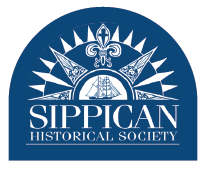 Here at the Sippican Historical Society, we know there is hardly anything more festive than a home-baked pie for the holiday season – so we are happy to share with you this particularly exciting piece from the Museum.
Here at the Sippican Historical Society, we know there is hardly anything more festive than a home-baked pie for the holiday season – so we are happy to share with you this particularly exciting piece from the Museum.
From the extensive Claflin Scrimshaw Collection comes this elaborately carved 19th century jagging wheel, sometimes called a pie crimper. Jagging wheels were kitchen implements, used for pie making, and are some of the more commonly made pieces of scrimshaw sailors created for their wives or loved ones. The wheel portion, after which the instrument is named, was for cutting dough and sealing down the edges of the pie crust in a pleasing pattern, while the fork that was often attached was for perforating the top of the crust to allow hot air to escape, and for decorating the top with patterns. While typically thought of as tools for baking pies, the wheels could be used for any kind of pastry making. Jagging wheels were utilitarian, but this did not stop scrimshanders from adding their own touch of whimsy to the creations they would hope to bring home to the women in their lives!
This whalebone example from our collection is extraordinary in its detail work. A gently tapering shaft supports a fluted wheel, above which is three-spoked fork is mounted. Halfway through the shaft is a contrasting strip of baleen, adding additional visual interest. The most delightful portion, however, is a twisting sea serpent, whose tail appears to curl around the main body of the piece. The head, inset with baleen eyes, rests upon the handle, next to its tail. The skill of the scrimshander lies in the fact that the handle, tail end, and head were all carved of the same piece of whalebone, while the body of the snake is carved of a separate piece and affixed to the serpent at joints. Can you image carving anything so detailed, let alone on a years-long sea voyage using only the tools on board?! The sea serpent appears to have been quite a popular motif, as examples in other museums will attest; however, this one in the Sippican Historical Society’s collection is relatively unique in its fine detail and ornate carving.
~ contributed by Abigail Field ~


